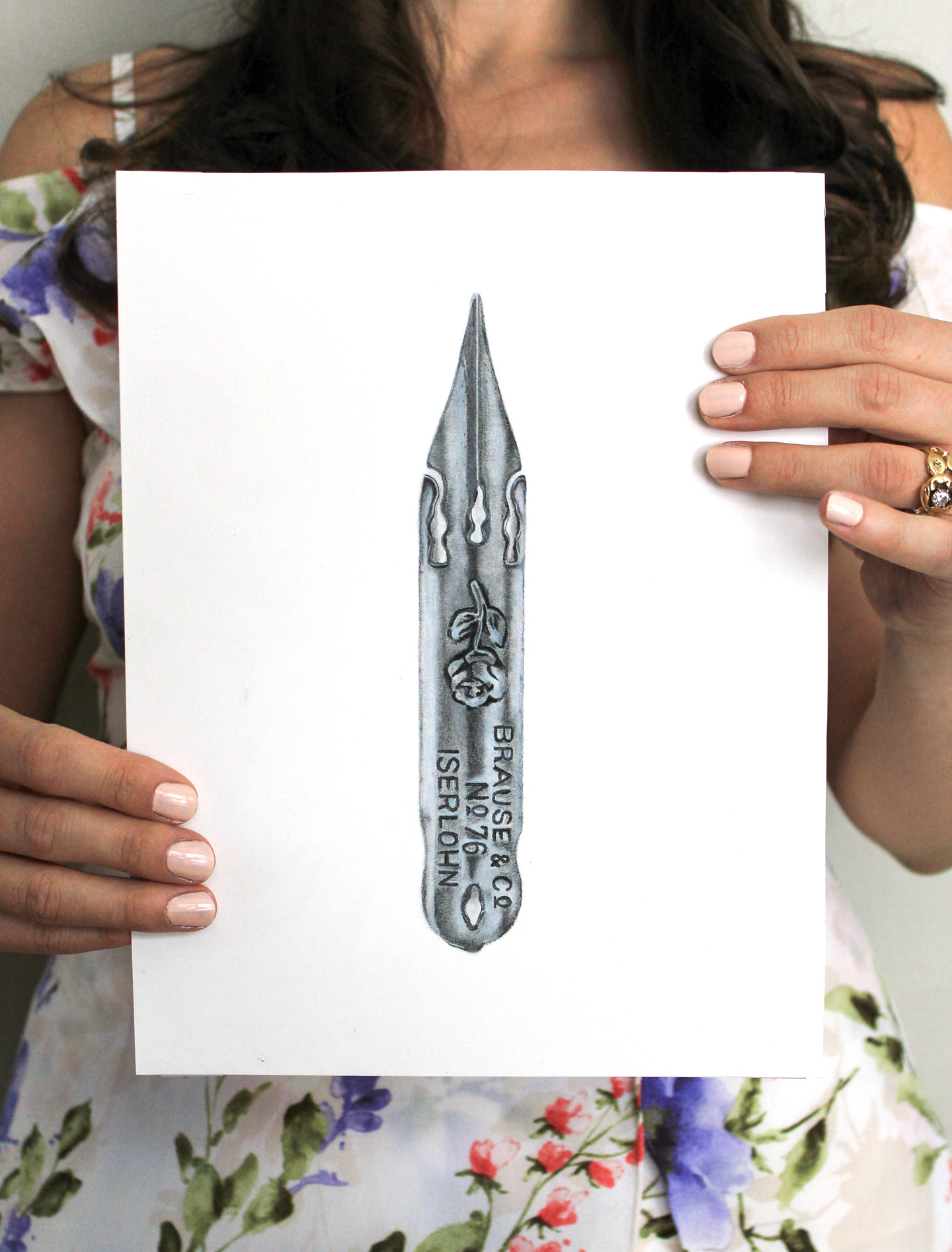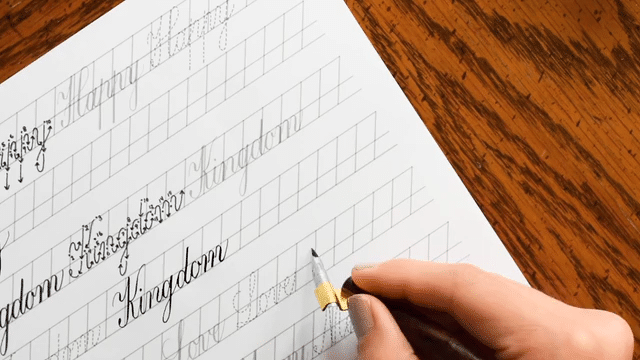
There’s so much to love about fabric invitations: they’re novel, interactive, and incredibly cost-effective if you DIY them! In today’s blog post, I want to walk you through a batch of fabric invitations that I recently designed as a gift for a friend’s wedding. It is my hope that seeing the process will inspire you to design and compile your own fabric/paper pieces for your next event!

Designing the Invitation
If you’re making a fabric invitation suite, the first thing to tackle is the invitation design. The best designs always start out with a plan, so it’s a good idea to draw a few rough sketches. If you’re making the fabric invitations for yourself, you can always ask for your loved ones’ opinions as far as which sketch is best. If you’re creating the invitations for a client, then you can send the sketches over to him/her and ask which one is their favorite (and if they would suggest any modifications)!

The next step is to put together the invitation design using Photoshop, Illustrator, or another design program. That might sound intimidating, but actually, Lesson 4 of the Digitizing Artwork and Calligraphy eCourse will walk you through it every step of the way! As the lesson describes, you’ll start by digitizing your artwork; in this case, that’s a watercolor illustration of tulips (painted with the fantastic Greenleaf & Blueberry Mayan Colors palette).

You’ll also need to create and digitize any calligraphy that you want to appear on the fabric invitations. In this example, I’m making wedding invitations, so I wrote out the bride and groom’s names in a few different calligraphy styles. It’s never a bad idea to try out a couple different kinds of lettering (I used Kaitlin Style, Janet Style, and a messy whatever-goes style in the photo below); you might be surprised at what looks good and what doesn’t!

Once you add the calligraphy and illustration to the blank invitation document in Photoshop (again, if it’s sounds like I’m speaking gibberish to you, the eCourse will explain it all), you can play around with adding computerized text and other design elements like lines. I always make a couple of different samples so I can pick a favorite (and/or give the client options)! For example, the invitations below feature different combinations of languages, as well as different versions of the date and location.

When the design is finished, it’s time to get the invitation ready for printing on fabric! First, you’ll want to fill out the TPK fabric invitation design template; you can download the template (in .psd [Photoshop] file format) by clicking here. Note that the template was created for 5″x7″ invitations and assumes you will be ordering your fabric in multiples of one yard (instead of ordering in fat quarters or test swatches). The filled-out template will look like this:

I always upload my designs to Spoonflower, which is a company that offers high-quality fabric printing services. I order the design to be printed on cotton poplin by the yard. You’ll get 28 invitations out of each yard, and each yard is $18.00 (at the time of writing this blog post) — that’s only ~$0.64 per invitation! If you’re using the TPK fabric invitation design template, be sure and change the DPI to 200; to do so, you’ll click “Change DPI” and type in “200” as shown in the screenshot below.

Additional Invitation Materials
Once you place your order on Spoonflower, you’ll have a couple of weeks to prepare other invitation materials while you wait for the fabric to arrive. The first thing I do after ordering the fabric is place an order for backing paper (to sew the fabric onto). The backing paper I use is the über-luxe cotton Crane’s Lettra 110 lb. paper in Fluorescent White; you can get it from Neenah Paper for free, actually. You just pay the cost of shipping! If you click here, then go to the “Samples” tab, you’ll want to select item #22236M. You can select up to four samples per order. When the samples arrive, you’ll notice they are large (12.5″ x 19″) pieces of paper; you’ll need to cut them down to 5″x7″ rectangles as shown below. I use a Dahle paper trimmer, but you could certainly cut the paper to size using scissors (and some patience)!

Note that you don’t have to use Crane’s Lettra paper; I just like it because it’s elegant and has an awesome texture! However, any card stock should do the trick.
Next, place an order for anything else that you would like to accompany your fabric invitations. For these particular invitations, I needed to design and order entry tickets — which was (literally) a foreign concept to me! My (Brazilian) friend Marina, who I made this suite for, explained that in Brazil, you often need an entry ticket to attend a wedding reception. This requirement deters would-be wedding crashers! I noticed that moo.com, a company that specializes in printing business cards, was having a sale, so I used their PSD business card templates (plus the tulips illustration and calligraphy) to whip up a card design.

If you’re not designing fabric invitations for a Brazilian wedding, you could absolutely design an RSVP card or maybe a watercolor wedding map to go with the suite. You can have your materials printed off locally, or you can use an online printer (my two favorite online printers are printingforless.com and smartpress.com)!
Once all your invitation materials are taken care of, it’s time to choose envelopes. I’m partial to Paper Source’s PS Collection envelopes in “Paper Bag”!

Cutting and Sewing the Fabric
After a week or two of waiting, your fabric will arrive. Just to forewarn you: it will be a bit wrinkled from shipping, so you’ll need to iron it. The fabric is colorfast, and will iron out to be nice and crisp! Next, you’ll want to take a rotary cutter (a great option) or fabric scissors (a sufficient option) and cut out the invitations along the lines.

After you cut out all the fabric invitations, you can experiment with using different stitches to affix them to the paper backing. You can see in the photo below that my mom — who does the sewing for all of the fabric invitations that I design — tried out a straight stitch (top), a close-together leaf stitch (middle), and a spaced-out leaf stitch (bottom). She used her sewing machine to achieve all of the stitches, and advises using a sharp needle!

Once you find a stitch that you like, you can sew all of the fabric invitations to the Lettra paper along the top. Depending on how many pieces you are making, it could take a few hours — but it’s totally worth how beautiful the invitations are!

Assembly
It’s always a good idea to tie your invitations together with something, whether that’s a belly band or something a little more unique. For this invitation suite, jute twine fits the bill for a fantastic presentation!

If you use something like jute twine, you need but tie it around the invitation. Once it’s tied nice and tight, you can tuck other invitation materials (in this case, the entry tickets) beneath the tie.

The result is simple, but lovely! In this case, the jute twine is reminiscent of what an actual bouquet of tulips — from a quaint farmers market, perhaps — might be tied with.

Envelope Calligraphy
One of the advantages of designing your own fabric invitations is being able to match the calligraphy on the invitations to the calligraphy on the envelopes. Since the fabric invitations showcased in this blog post use Janet Style calligraphy, that’s what the envelopes feature as well. If you’re creating Janet Style calligraphy, you can use the envelope template included in Amazing Envelopes for a Latté to draw guidelines.

You can use any ink, but I love iron gall for its ability to make elegant, thin upstrokes!

Make sure you wait until the ink is completely dry before you erase the guidelines! The drying time for iron gall ink is about 10 minutes.

Sending
Fabric invitations are whimsical in the best of ways, and I think a great way to complement that is with an equally whimsical vintage stamp collage! In the US, you can buy unused stamps on eBay or Etsy; as long as they total or exceed the cost of mailing the invitation ($0.49 if your invitation is 1 oz. or less and is being sent domestically), then they will safely reach their destination.

Summary
I hope you enjoyed this post over how to make DIY fabric invitations! I know that you were presented with a lot of information about this process, so here’s a concise to-do list that will come in handy if you want to make these:
- Create illustrations and calligraphy to be used in the invitation design.
- Put together the invitation design using Photoshop or another program (you can learn how in the Digitizing Artwork and Calligraphy eCourse).
- Use the design to fill out the fabric invitation design template, then upload the template to Spoonflower and order Cotton Poplin fabric.
- Buy card stock for the invitation backing, and cut the stock to size if necessary.
- Make and print any extra invitation materials (e.g. RSVP cards, information cards).
- Buy envelopes.
- Cut out the fabric invitations, and sew them on to the card stock backing.
- Assemble your invitation suites (“tie” everything together with twine or belly bands).
- Calligraph the envelopes.
- Send!

If you have any questions about how to create your own DIY fabric invitations, please don’t hesitate to ask! They are super, super cool, and I know you’ll just love them. They are easy on the budget, too: the cost for 140 of the invitations shown in this post– including envelopes, entry tickets, and twine — averaged out to $1.75 apiece! Considering how gorgeous they are, I’d say that’s a steal. 🙂
Thanks so much for reading TPK, and enjoy your weekend!
Warmly,

*This post contains affiliate links to Amazon

























